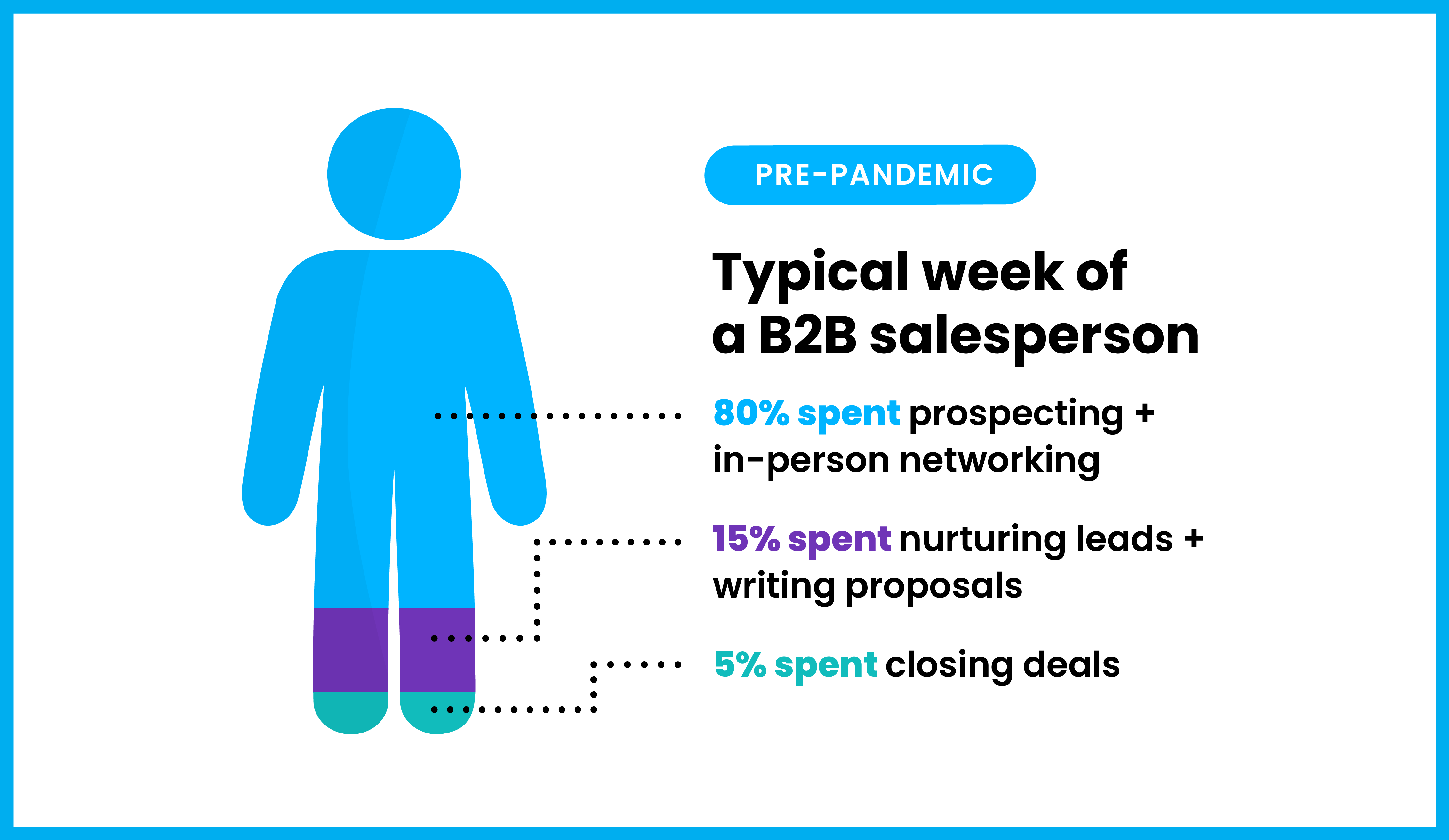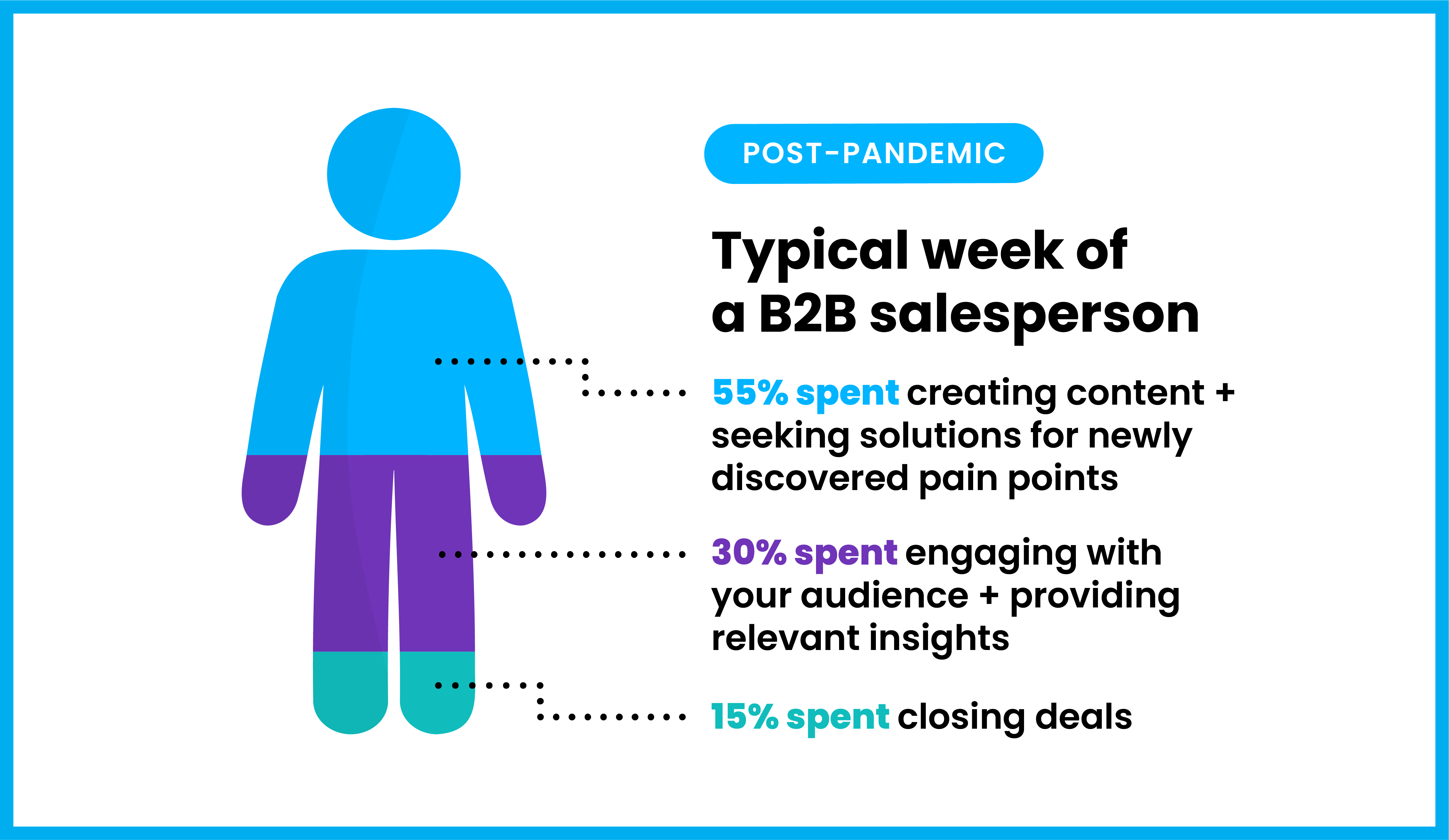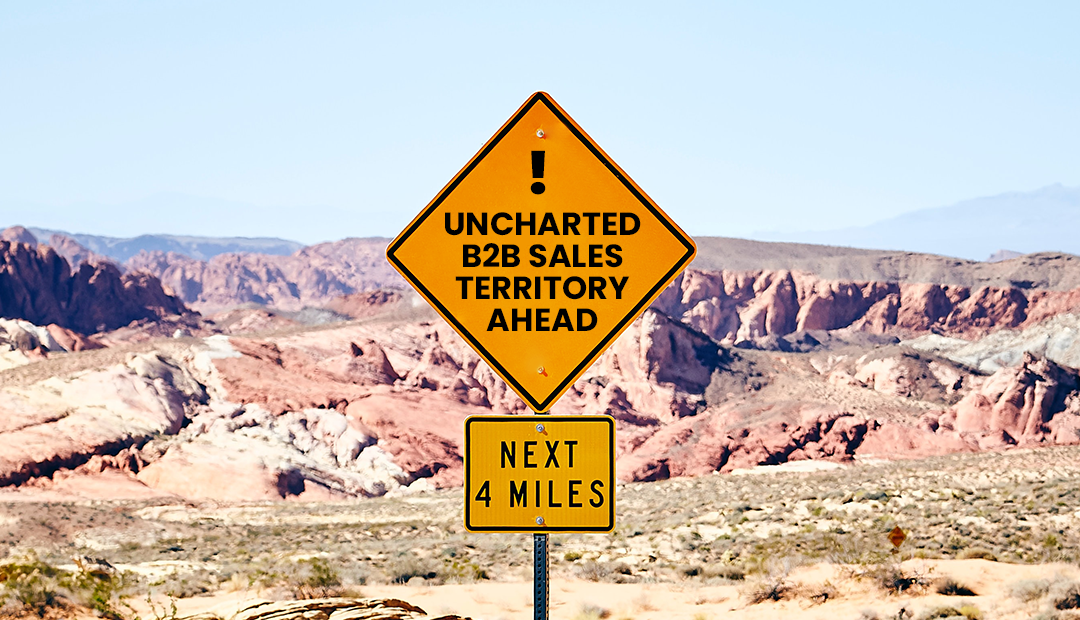It’s the end of an era for sales folks. Roaring into a new year, and a new consumer environment, B2B salespeople are finding themselves in some very unfamiliar territory.
Over the last 13 years in B2B sales, we’ve had the opportunity to witness some pretty exciting breakthroughs, from the explosion of social media to the transformation of mobile media consumption. Through all of these shifts in consumer behavior over the last decade, nothing comes close to the impact that 2020 had on the B2B sales industry.
In an effort to grasp what has happened, we should first look at the typical week of a B2B salesperson before COVID:

The tactics for salespeople pre-COVID were relatively straightforward: get involved in local business chapters, pound the pavement, show up to places, make phone calls and grow your network to funnel new opportunities.
All of this was being done in a hand-to-hand combat sort of approach. Meaning a large percentage of a salesperson’s typical week was made up of outbound sales strategies or prospecting. This was a fine strategy too, given the previous environment’s availability to provide trade shows, networking events, and a willingness, though declining, to meet with salespeople. All now gone.
A paradigm shift
This has left a huge void in many B2B salespeople’s day-to-day. Where an 80% effort in outbound prospecting would result in 20% effort in nurturing those leads and closing deals, salespeople are finding it increasingly difficult to get the same results out of 80% of their time. Demand Gen recently reported that 87% of the B2B buyers’ customer journey now takes place online doing independent online research, and 13% of their buyer journey involves speaking with a sales professional.
Bottom line: they don’t want to talk to us (salespeople) like they used to. They want 87% of their questions answered before they pick up the phone.
This is a huge paradigm shift in B2B buyers and something many corporations and salespeople are reluctant to accept. We hear it all the time … “our customers don’t buy online,” “we are a person-to-person business,” “our customers have to speak with someone in order to make a purchase.” While all of this may be true, don’t forget, most organizations have already made up their mind before they sit down with you.
The role of today’s salesperson has changed. We can no longer make a living prospecting and mining opportunities. We must now position ourselves and our organizations as thought leaders and problem-solvers without ever speaking to our prospects.
What does this mean? Salespeople have to integrate with their marketing teams. We, as salespeople, can no longer make our living using the same tactics we used pre-COVID, living on our own island, pretending marketing doesn’t work in our industry and relationships are the basis of business development.
Our customers no longer believe this to be true. What they want is the ability to answer a majority of their questions and learn about YOU, the salesperson, before they actually talk to you. This now requires our customer knowledge to be categorized, branded and packaged for delivery to our prospects, on their terms. This is where marketing can help.
Great salespeople – and I mean truly valuable salespeople – know their customers more than any marketing wizard ever will. This is not why you need them. You need marketing people so they can effectively package and distribute what matters most to your prospects in the medium and timeline that your customers want it, and to be clear, this doesn’t include multiple meetings with you to uncover their pain points.
This responsibility (to understand exactly what your customer wants and how you can provide it) has shifted away from sales departments and moved into marketing departments. B2B buyers are demanding middle- to lower-funnel buyer data, early in the customer journey and without meeting anyone from your company, especially a salesperson. This has created a huge gap in the level of information your customers look for early in the buyer’s process and the lack of information being provided to them during this phase.
How do we bridge this gap?
The dawn of a new era is here and we can no longer accept our reluctance to change. The reality is that the expectations of our customers have drastically changed forever.
Today’s B2B salesperson doesn’t look like a salesperson at all. They look more like industry experts who are not focused on sales but focused on growing, educating and engaging their audience. They look a lot more like revered professors, the teachers whose classes were hard to get into because everyone wanted to learn from them.

Creating value early in the journey
The importance of content creation has been screamed about for many years; everyone gets it. The disconnect for most organizations involves the type of content they are creating. Far too often, we see organizations throwing more and more capital at “creating content,” but no one is asking if the content they are creating is actually important to their customers and prospects. Essentially, no one is asking the sales team.
What is even more troubling, is that when marketers do ask their sales teams for input, salespeople often leave out the most important pieces of information with the false assumption that their prospect has to hear this from the salesperson later in the buyer’s journey.
This ultimately leads to the marketing team creating ‘fluff’ content that no one cares about, ending up in failed attempts to generate meaningful engagements with prospects. This has to stop!
Success will be granted to the organizations that fight the fear of ‘saying too much too early’ and instead adopt a philosophy of generating content that their prospects value the most and addressing those topics early in the buyer’s journey.
The way to succeed with today’s B2B buyers is to give them the ability to make up their mind to work with you before you ever speak to them. This is a hard pill to swallow for many sales-led organizations. Many companies have been indoctrinated with the assumption that the way to grow sales is to grow the sales team. This model is over.
The new winners will be the organizations who choose to put prospecting quotas aside and form sales and marketing quotas that are driven by the number of times your solutions were considered when others were researching their problems. Instead of looking at appointments and the number of phone calls our sales teams can make in a week, we need to start measuring not just our content output, but the level of engagement we received from that output.










